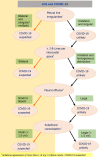Comprehensive literature review on the radiographic findings, imaging modalities, and the role of radiology in the COVID-19 pandemic
- PMID: 34630913
- PMCID: PMC8473437
- DOI: 10.4329/wjr.v13.i9.258
Comprehensive literature review on the radiographic findings, imaging modalities, and the role of radiology in the COVID-19 pandemic
Abstract
Since the outbreak of the coronavirus disease 2019 (COVID-19) pandemic, over 103214008 cases have been reported, with more than 2231158 deaths as of January 31, 2021. Although the gold standard for diagnosis of this disease remains the reverse-transcription polymerase chain reaction of nasopharyngeal and oropharyngeal swabs, its false-negative rates have ignited the use of medical imaging as an important adjunct or alternative. Medical imaging assists in identifying the pathogenesis, the degree of pulmonary damage, and the characteristic features in each imaging modality. This literature review collates the characteristic radiographic findings of COVID-19 in various imaging modalities while keeping the preliminary focus on chest radiography, computed tomography (CT), and ultrasound scans. Given the higher sensitivity and greater proficiency in detecting characteristic findings during the early stages, CT scans are more reliable in diagnosis and serve as a practical method in following up the disease time course. As research rapidly expands, we have emphasized the CO-RADS classification system as a tool to aid in communicating the likelihood of COVID-19 suspicion among healthcare workers. Additionally, the utilization of other scoring systems such as MuLBSTA, Radiological Assessment of Lung Edema, and Brixia in this pandemic are reviewed as they integrate the radiographic findings into an objective scoring system to risk stratify the patients and predict the severity of disease. Furthermore, current progress in the utilization of artificial intelligence via radiomics is evaluated. Lastly, the lesson from the first wave and preparation for the second wave from the point of view of radiology are summarized.
Keywords: Brixia score; COVID-19; Computed tomography; Coronavirus; MuLBSTA Scoring system; Radiological Assessment of Lung Edema classification; Ultrasound.
©The Author(s) 2021. Published by Baishideng Publishing Group Inc. All rights reserved.
Conflict of interest statement
Conflict-of-interest statement: Authors declare no conflict of interest for this article.
Figures












References
-
- World Health Organization. Laboratory testing for 2019 novel coronavirus (2019-nCoV) in suspected human cases 19 March 2020. [cited 22 January 2021]. Available from: https://www.who.int/publications/i/item/10665-331501 .
Publication types
LinkOut - more resources
Full Text Sources
Research Materials

